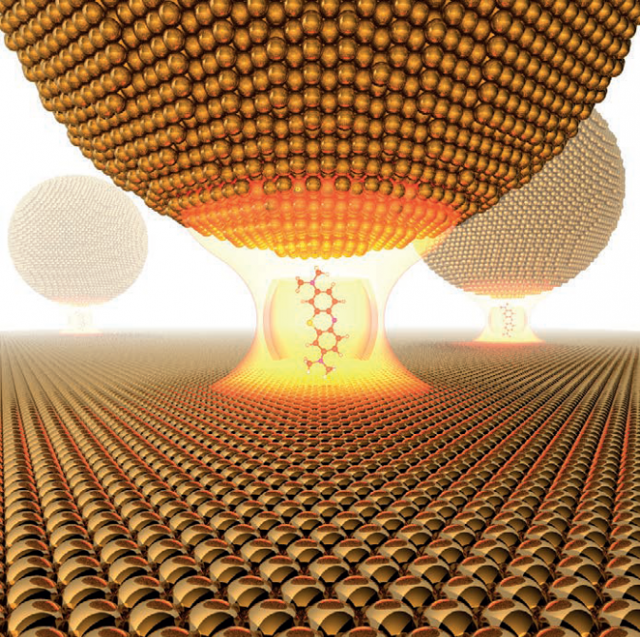Plasmons galore for myriad applications
Worldwide research efforts on plasmons and metamaterials have been growing exponentially for the past ten years. Now, Antonio I. Fernández-Domínguez (IFIMAC), Francisco J. García-Vidal (IFIMAC & DIPC), and Luis Martín-Moreno (ICMA) discuss new directions for the future, such as the use of 2D materials and strong coupling phenomena, which are likely to shape the field over the next decade in an article 1 published in Nature Photonics. Some excerpts follow.
For centuries, metals were employed in optical applications only as mirrors and gratings. New vistas opened up in the late 1970s and early 1980s with the discovery of surface-enhanced Raman scattering and the use of surface plasmon (collective electronic oscillations at the surface of metals) resonances for sensing. However, it was not until the 1990s, with the appearance of accurate and reliable nanofabrication techniques, that plasmonics blossomed.
Initially, the attention focused on the exploitation of surface plasmons for sensing, subwavelength waveguiding and extraordinary optical transmission. Since then, the scientific and technological interest in surface plasmons has expanded.
In a simplified picture, there are five distinctive characteristics that make surface plasmons attractive: their ability to concentrate light beyond the diffraction limit; their ability to modify the local density of photonic states; their ultrafast response; their environmental sensitivity; and their flexibility in design. The main factor limiting their use is the high optical absorption inherent to metals. Therefore, the quest for minimizing dissipative damping has been a crucial driving force for plasmonics.
The advent of graphene has inspired research into 2D materials defined by their atomic thickness, some of which are very promising for applications in both the terahertz and mid-infrared regimes. Doped graphene supports surface plasmons in these frequency ranges, featuring out-of-plane decay lengths and in-plane wavelengths that can be three orders of magnitude smaller than free-space radiation. This fact, together with their large electrical tunability, makes graphene plasmons excellent candidates for resonators and sensors. Despite the inherent absorptive character of graphene, there are reasons for being optimistic about the prospects of reducing damping in graphene-based plasmonics.
The efficiency of surface-plasmon-based phenomena in metallic platforms has been pushed to unprecedented limits, opening the way for a myriad of applications. For example, through the implementation of nanoscale plasmonic tips, spectroscopic techniques are approaching the level of chemical recognition and spatial resolution required to identify single molecules. It is likely that the combination of advances in nanometrology and a deeper understanding of Raman enhancement mechanisms will establish single-molecule spectroscopy as a widespread tool. Similarly, the large field enhancement and acute environmental sensitivity of surface plasmons are being exploited in prototypes for microfluidic sensors. These are versatile and label-free instruments able to detect extremely low sample volumes and concentrations. Furthermore, surface plasmons are key ingredients for optical nanotweezers, which take advantage of the complex force fields that originate from plasmonic light confinement to trap and accurately manipulate individual nano-objects in real time. This surface-plasmon-assisted miniaturization of equipment (spectroscopes, biosensors and tweezers, among many others) has made possible lab-on-a-chip devices integrating all the functionalities of a conventional laboratory, and is currently close to industrial production.

By shrinking their modal volume, the interaction between surface plasmons and an ensemble of quantum emitters (quantum dots and organic molecules) can be pushed into the so-called collective strong coupling regime. This phenomenon takes place when light and matter states exchange energy faster than their respective decay channels, giving rise to new quasiparticles usually termed plasmon–exciton–polaritons. The properties of these hybrid states can be adjusted through their light and matter content, which means a new, and qualitatively different, degree of light manipulation. A different research route consists of taking advantage of the phenomenon of collective strong coupling to take chemistry and materials science into new directions, that is, modifying chemical and material properties through vacuum fluctuations. We envisage that plasmonic cavities will find applications as catalysts, inhibitors of chemical reactions, and enhancers of energy and charge transport, prospects that are now attracting much fundamental research.
Author: César Tomé López is a science writer and the editor of Mapping Ignorance.
References
- Antonio I. Fernández-Domínguez, Francisco J. García-Vidal & Luis Martín-Moreno (2017) Unrelenting plasmons Nature Photonics doi: 10.1038/nphoton.2016.258 ↩